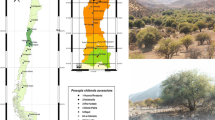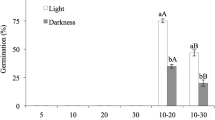Abstract
Psammochloa villosa (Trin.) Bor. (Poaceae), is distributed primarily in moving sand dunes of the Ordos Plateau, China. Freshly harvested caryopses (seeds) are in non-deep physiological dormancy (non-deep PD). Germination is slow and low and only over a narrow temperature range. A treatment of four weeks cold stratification at 3 to 5 °C in darkness was required to break non-deep PD, allowing germination to reach high percentages at higher temperatures and without light requirement. Rate and percentages of germination were increased by scarifying the caryopsis coat and by artificial removal of different proportions of the endosperm. However, seedling dry weight and increases in root and shoot lengths, were significantly influenced by the proportion of the endosperm that remained on the caryopses. Higher percentages of seedling emergence were obtained from the shallowly buried caryopses, ranging from 0.5–2.0 cm, and the depth of the caryopses in the sand affected the time of germination. The deeper the caryopses were buried, the more that remained ungerminated and in enforced dormancy. The caryopses germinated when the upper sand layer was removed and buried caryopses were at a suitable sand depth for germination, or when the sand was aerated. In natural habitats, germinated seedlings may be wholly exposed to the air by sand erosion and thus be exposed to drought stress. However, young seedlings have the ability to tolerate desiccation and to recover after rehydration. Root length at the `point of no return' is 4 mm.
Similar content being viewed by others
References
Baskin J M and Baskin C C 1982 Effect of wetting and drying cycles on the germination of seeds of Cyperus inflexus. Ecology 63, 248–252.
Baskin C C and Baskin J M 1998 Seeds. Ecology, Biogeography, and Evolution of Dormancy and Germination. Academic Press, San Diego. 666 pp.
Baskin C C, Baskin J M and Meyer S E 1993 Seed dormancy in the Colorado Plateau shrub Mahonia fremontii (Berberidaceae) and its ecological and evolutionary implications. Southw. Nat. 38, 91–99.
Come D 1982 Germination. In Croissance et développement. Physiologie végétale II. Ed. P Mazliak. pp. 129–225. Hermann, Paris.
Cranston H J, Kern A J, Gerhardt S A and Dyer W E 1996 Wound-induced ethylene and germination of embryos excised from Dormant Avena fatua L. Caryopses. Int. J. Plant Sci. 157, 153–158.
Datta S C, Gutterman Y and Evenari M 1972 The influence of the origin of the mother plant on yield and germination of their caryopses in Aegilops ovata L. Planta 105, 155–164.
Debaene-Gill S B, Allen P S and White D B 1994 Dehydration of germinating ryegrass seeds can alter rate of subsequent radicle emergence. J. Exp. Bot. 278, 1301–1307.
Dong M and Alaten B 1999 Clonal plasticity in response to rhizome severing and heterogeneous resource supply in the rhizomatous grass Psammochloa villosa in an Inner Mongolian dune, China. Plant Ecol. 141, 53–58.
Dubrovsky J G 1996 Seed hydration memory in Sonoran Desert cacti and its ecological implications. Am. J. Bot. 83, 624–632.
Evenari M 1965 Physiology of seed dormancy, after-ripening and germination. Proc. Int. Seed Test. Assn. 30, 49–71.
Evenari M, Shanan L and Tadmor N 1971 The Negev, the challenge of a desert. Harvard University Press, Cambridge, MA.
Friedman J, Stein Z and Rushkin E 1981 Drought tolerance of germinating seeds and young seedlings of Anastatica hieron-chuntica L. Oecologia 51, 400–403.
Gardener C J, McIvor J G and Jansen A 1993 Passage of legume and grass seeds through the digestive tract of cattle and their survival in faeces. J. Appl. Ecol. 30, 63–74.
Gutterman Y 1993 Seed Germination in Desert Plants. Adaptations of Desert Organisms. Springer-Verlag, Berlin. 253 pp.
Gutterman Y 2000a Seed dormancy as one of the survival strategies in annual plant species occurring in deserts. In Dormancy in Plants: From Whole Plant Behaviour to Cellular Control. Eds. J-D Viemont and J Crabbé. pp. 139–159. CABI Publishing, Wallingford.
Gutterman Y 2000b Genotypic and phenotypic germination survival strategies of ecotypes and annual plant species in the Negev Desert of Israel. In Seed Biology: Advances and Applications. Proceedings of 6th International Workshop on Seeds, Merida, Mexico, 24–28 January 1999. Eds. M Black, K J Bradford and J Vazquez-Ramos. pp. 389–399. CABI Publishing, Wallingford.
Gutterman Y 2000c Environmental factors and survival strategies of annual plant species in the Negev Desert, Israel. Plant Spec. Biol. 15, 113–125.
Gutterman Y 2001a Regeneration of Plants in Arid Ecosystems Resulting from Patch Disturbance. Geobotany 27. Kluwer Academic Publishers, Dordrecht. 260 pp.
Gutterman Y 2001b Drought tolerance of the dehydrated root of Schismus arabicus seedlings and regrowth after rehydration, affected by caryopses size and duration of dehydration. Isr. J. Plant Sci. 49, 123–128.
Gutterman Y 2002 Survival Strategies of Annual Desert Plants. Adaptations of Desert Organisms. Springer-Verlag, Berlin. 348 p.
Gutterman Y, Corbineau F and Come D 1996 Dormancy of Hordeum spontaneum caryopses from a population on the Negev Desert Highlands. J. Arid Environ. 33, 337–345.
Gutterman Y, Evenari M, Cooper R, Levy E C and Lavie D. 1980 Germination inhibition activity of a naturally occurring lignan from Aegilops ovata L. in green and infrared light. Experientia 36, 662–663.
Gutterman Y and Gozlan S 1998 Amounts of winter or summer rain triggering germination and ‘the point of no return’ of seedling desiccation tolerance of Hordeum spontaneum. Plant Soil 204, 223–234.
Harper J L 1977 Population Biology of Plants. Academic Press, London. 892 p.
Huang Z and Gutterman Y 1998 Artemisia monosperma achene germination in sand: Effects of sand depth, sand/moisture content, cyanobacterial sand crust and temperature. J. Arid Environ. 38, 27–43.
Huang Z and Gutterman Y 1999 Germination of Artemisia sphaerocephala (Asteraceae), occurring in the sandy desert areas of Northwest China. South Afr. J. Bot. 65, 187–196.
Huang Z and Gutterman Y 2000 Comparison of germination strategies of Artemisia ordosica with its two congeners from deserts of China and Israel. Acta Bot. Sin. 42, 71–80.
Huang Z, Gutterman Y and Hu Z 2000 Structure and function of mucilaginous achenes of Artemisia monosperma inhabiting the Negev Desert of Israel. Isr. J. Plant Sci. 48, 255–266.
International Seed Testing Assn. 1985 International rules for seed testing. Seed Sci. Tech. 13, 299–355.
Janzen D H 1971 Escape of Cassia grandis L. beans from predators in time and space. Ecology 52, 964–979.
Lavie D, Levy E C, Cohen A, Evenari M and Gutterman Y 1974 New germination inhibitor from Aegilops ovata L. Nature 249, 388.
Liu Y 1985 Flora in Desertis Reipublicae Populorum Sinarum. Volume I. Science Press, Beijing. 357 pp.
Maun M A 1998 Adaptations of plants to burial in coastal sand dunes. Can. J. Bot. 76, 713–738.
Meyer S E and Kitchen S G 1994 Habitat-correlated variation in seed germination response to chilling in Penstemon Section Glabri (Scrophulariaceae). Am. Midl. Nat. 132, 349–365.
Mitrakos K and Diamantoglou S 1984 Endosperm dormancy breakage in olive seeds. Physiol. Plant. 62, 8–10.
Pemadasa M A and Lovell P H 1975 Factors controlling germination of some dune annuals. J. Ecol. 63, 41–59.
Roels B, Donders S, Werger M and Dong M. 2001. Relation of wind-induced sand displacement to plant biomass and plant sand-binding capacity. Acta Bot. Sin. 43, 979–982.
Sokal R R and Rohlf E J 1995 Biometry. 3nd ed. Freeman, San Francisco, CA.
Yin Z B 1994 Genus Psammochloa villosa. In Flora of Inner Mongolia (Vol. 5) 2nd Ed. Y Q Ma. pp. 115–152. Inner Mongolia People Press, Huhhot.
Young J A and Evans R A 1979 Arrowleaf balsamroot and mules ear seed germination. J. Range Manage. 32, 71–74.
Zhang J and Maun M A 1989a Seed dormancy of Panicum virgatum L. on the shoreline sand dunes of Lake Erie. Am. Midl. Nat. 122, 77–87.
Zhang J and Maun M A 1989b Effect of partial removal of endosperm on seedling sizes of Panicum virgatum and Agropyron psammophilum. Oikos 56, 250–255.
Zhang J and Maun M A 1990 Effects of sand burial on seed germination, seedling emergence, survival, and growth of Agropyron psammophilum. Can. J. Bot. 68, 304–310.
Zhang X 1994 Principles and optimal models for development of Maowusu Sandy Grassland. Acta Phytoecol. Sin. 18, 1–16.
Author information
Authors and Affiliations
Rights and permissions
About this article
Cite this article
Huang, Z., Dong, M. & Gutterman, Y. Factors influencing seed dormancy and germination in sand, and seedling survival under desiccation, of Psammochloa villosa (Poaceae), inhabiting the moving sand dunes of Ordos, China. Plant and Soil 259, 231–241 (2004). https://doi.org/10.1023/B:PLSO.0000020971.66784.fc
Issue Date:
DOI: https://doi.org/10.1023/B:PLSO.0000020971.66784.fc




